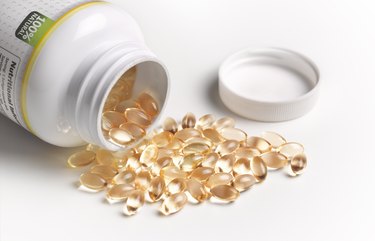How Long To Increase Vitamin D Levels With Supplements
How Long To Increase Vitamin D Levels With Supplements

You'll start feeling better after your vitamin D supplements take effect — just give it a few months.
Image Credit: Peter Dazeley/Photographer's Choice/GettyImages
Having a vitamin D deficiency can leave you feeling tired, weak and depressed. If you suspect your levels are low, talk to your doctors. They'll create a plan to improve your vitamin D levels within a few months.
Working with your doctor is easier than you think. The benefits of taking a multivitamin may be enough to improve your vitamin D levels. In more severe cases, you'll need a regimen of high-dose vitamin D. Your doctor will check your blood work to determine the right course of action.
Tip
How long it takes for you to feel the effects of your vitamin D supplement depends on the severity of your deficiency. It may take weeks or months. Your doctor will monitor your blood levels of vitamin D and adjust your dose accordingly.
How Soon Will You Feel Better After Taking Vitamin D Supplements?
After starting your doctor's recommended dosage, the question is, when will it work? The answer isn't the same for everyone.
The National Institutes of Health states that the more depleted you are, the longer it takes for changes to occur. An article in the September 2016 issue of the Journal of Oncology Practice says that, generally, after a few weeks of treatment, vitamin D levels will increase at 1 ng/mL for every 40 IU taken. You should start feeling better once the vitamin D kicks in, but you should still have your levels checked every two to three months.
Remember it's always easier to avoid deficiency than it is to rebuild your system. So pay attention to what your body is telling you.
What You Need to Know
Vitamin D plays an essential role in your body. According to an article on UpToDate, which was updated in February 2019, your vitamin D blood level should be at least 30 ng/mL. That means anything over 30 ng/mL is considered healthy. These ranges are often debated, but it's generally agreed that anything under 20 ng/mL is a deficiency.
Meanwhile, a January 2018 article in the Journal of Steroid Biochemistry and Molecular Biology noted that toxicity begins around 125 ng/mL. This means that the healthy range is somewhere between 30 ng/mL and 120 ng/mL, which is quite a difference.
Less Common Than You Think
You may have heard that vitamin D deficiency is prevalent. While it's true that you should have your doctor monitor your levels, it's not as common as perceived.
A 2018 Yale Medicine article goes as far as calling the prevalence of vitamin D deficiency a myth. There are, however, some populations that are at higher risk than others. Those who live in areas without a lot of sun, breastfed infants (due to breast milk's low vitamin D concentrations) and some minorities are at higher risk of becoming deficient.
During the summer, it's easy to get enough vitamin D, but a lack of sun in the winter can lead to a deficiency. You may find your body craving the benefits of taking a multivitamin with a high dose of vitamin D.
Vitamin D and Your Body
There's so much that vitamin D does for the body. It's linked to improving mood, increasing energy and boosting the immune system.
A March 2014 review in the Journal of Pediatric Rehabilitation Medicine indicates that Vitamin D has been found to help with:
- Bone health
- Balance
- Muscle weakness
- Pain
A review and meta-analysis published in 2015 in Obesity Reviews notes the link between obesity and vitamin D deficiency. Don't go doubling your D intake just yet, though. Taking a dose of vitamin D at 50,000 IU for weight loss has yet to be proven effective.
Signs of Vitamin D Deficiency
Before talking to your doctor, check yourself for signs of vitamin D deficiency. According to a study published in May 2015 in Psychiatry Research, depression is a common symptom of deficiency. In addition, a June 2014 article in Archives of Women's Health's suggests an increased likelihood of postpartum depression, which further supports the link between insufficient vitamin D and depression.
Additional symptoms, according to University Health News, include:
- Anxiety
- Fatigue
- Muscle cramps
- Joint pain
- Low immunity
- Soft bones
- Irritability
Sources of Vitamin D
There are plenty of sources available for vitamin D once your deficiency has been determined.
The sun is a great source, as are several foods, such as salmon. If you're struggling with deficiency levels though, the vitamin D in salmon won't be enough. The National Institutes of Health suggests that the best source of vitamin D is a quality supplement.
To decide which supplement is best for you, take your time and do some research. Vitamins can have undesired side effects, and vitamin manufacturers sometimes stretch the reality of their claims. Even those that are effective still may not be right for you. For instance, the Alive! Women's Energy brand produces side effects from its high dosage of iron, which can upset sensitive stomachs.
How Long To Increase Vitamin D Levels With Supplements
Source: https://www.livestrong.com/article/532981-how-long-does-it-take-to-feel-the-effects-of-vitamin-d-supplements/


Tidak ada komentar:
Tulis komentar